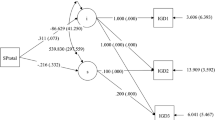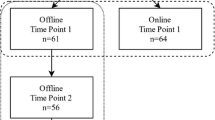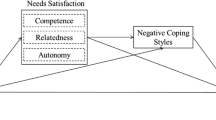Abstract
Internet Gaming Disorder (IGD) has been introduced as an emerging mental health condition requiring further study. Associations between IGD and gaming presence (i.e., absorption in the virtual environment) have been implied. The aim of the present study was twofold: (a) to evaluate the extent to which presence contributes to IGD severity and (b) to examine longitudinal differences in IGD according to the initial level of presence experienced. The participants comprising 125 emerging adults aged 18 to 29 years completed either (i) three face-to-face assessments (1 month apart, over 3 months) or (ii) a cross-sectional, online assessment. IGD was assessed with the 9-item IGD Scale Short Form and presence was assessed using the Presence Questionnaire. Regression and latent growth modeling analyses were conducted. Findings demonstrated that the level of gaming presence related to IGD severity but not to linear change in severity over a 3-month period. The study shows that emergent adults who play Internet games may be at a high risk of IGD given a more salient sense of being present within the gaming environment. Clinical implications considering prevention and intervention initiatives are discussed.


Similar content being viewed by others
Notes
To ensure that there were no significant differences between the online and face-to-face samples considering their demographic and Internet use characteristics, as well as the variables used in the present study, independent sample t tests and chi-square analyses were conducted. Findings did not indicate any significant differences in regard to gender (x2 = .21, df = 1, p = .89), the type of game genre (i.e., MMOs without role development vs MMOs with role development) played (x2 = 2.59, df = 1, p = .61), the age of the participants (t = − .54, df = 120, p = .59), their years of internet use (t = 2.35, df = 122, p = .06), and their reported level of online presence (t = − 1.595, df = 119, p = .113). Therefore, online and face-to-face data (i.e., TP1) were combined (i.e., analyzed together) for the cross-sectional analyses.
The longitudinal design was assessed for attrition. Assessments’ frequency for each participant varied within a range of 1–3 (Maverage = 2.57). T1 comprised 61 participants, T2 comprised 56 participants (8.20% attrition) and T3 comprised 43 participants (29.51% attrition). In line with literature recommendations, attrition, in relation to the studied variables, was assessed using Little’s missing completely at random (MCAR) test, which was insignificant37 (MCAR X2 = 1715.79, p = 1.00; Little and Rubin 2014). In order to avoid list-wise deletion, which would reduce the sample’s power, maximum likelihood imputation (five times) of values was applied (Gold and Bentler 2000).
To ascertain that the data collection type did not confound the association between presence and IGD scores, the linear regression analysis (bootstrapping at 1000) of presence predicting IGD was additionally conducted separately for the online [F(1, 63) = 10.12, p = .003, R2 = .17, b = 0.44, SE (b) = 0.14, t = 3.18, p = .003] and the face to face [F(1, 60) = 14.59, p = .000, R2 = .20, b = 0.38, SE (b) = 0.10, t = 3.82, p = .000] data resulting to similar findings with those of the unified sample. Furthermore, a moderation analysis was conducted using the process software (Hayes 2013). The model examined the potential moderating effect of the data collection type (0 = online, 1 = face-to-face) on the association between presence (IV) and IGD (DV). Results indicated that presence and the type of data collection did not significantly interact in predicting IGD score [b = .06, SE = 0.17, t(543) = .34, p = .731, (lower level confidence interval = − .273 upper level confidence interval = .388)].
The current study is part of a wider project (redacted for review) that addresses the interplay between individual, Internet, and proximal context factors in the development of Internet Gaming Disorder symptoms among emerging adults. Instruments used in the data include the following: (1) Internet Gaming Disorder 9-Short Form (Pontes and Griffiths 2015); (2) Beck Depression Inventory–2nd edition (21 items; Beck et al. 1996); (3) Beck Anxiety Inventory (21 items; Beck and Steer 1990); (4) Hikikomori-Social Withdrawal Scale (five items; Teo et al. 2015); (5) Attention Deficit Hyperactivity Self-Report Scale (18 items; Kessler et al. 2005); (6); 10-Item Personality Inventory (Gosling et al. 2003); (7) The Balanced Family Cohesion Scale (seven items; Olson 2000); (8) Presence Questionnaire (10 items; Ratan and Hasler 2010); (9); Online Flow Questionnaire (five items; Chen et al. 2000); (10) Self-Presence Questionnaire (Ratan and Hasler 2010); (11) The Gaming-Contingent Self-Worth Scale (12 items; Beard and Wickham 2016); and (12) Demographic and Internet Use Questions. The battery of questionnaires was utilized for both online and face-to-face data collection. The use of the fitness tracker (Fitbit flex) was used only for face-to-face data collection. Data have not been used in any previous published studies.
In line with the approval received by the ethics committee of (redacted for review), the flyers (a) indicated that participants were required to participate on three separate measurement occasions approximately 1 month apart; (b) included an email address to contact the investigators; and (c) clearly described the process and stages of the data collection (face-to-face and online). MMO and MMORPG players, aged between 18 and 29 years old, interested in the study received the Plain Language Information Statement (PLIS). The PLIS clearly indicated that participation was voluntary and that participants could independently decide to withdraw from the study at any point. Individuals who choose to participate were required to provide informed consent.
The model is regarded as acceptable if the chi-square is not significant. That is, the observed covariance matrix is similar to the matrix predicted by the model. However, this index is disregarded when the sample size exceeds 200 and in the cases that the assumption of multivariate normality is violated.
The RMSEA represents the square root of the average or mean of the covariance residuals (the differences between corresponding elements of the observed and predicted covariance matrix). Zero represents a perfect fit. Literature indicates that RMSA should be less than .08 (Browne and Cudeck 1992)—and ideally less than .05 (Steiger 1990). Alternatively, the upper confidence interval of the RMSEA should not exceed .08 (Hu and Bentler 1998).
The CFI compares the examined model of interest with the null or independence model (variables are assumed to be uncorrelated). In this context, the CFI represents the extent to which the model of interest is better than is the independence model. Values that approach 1 indicate acceptable fit. CFI is not too sensitive to sample size (Fan et al. 1999).
The TLI is computed by the division of the chi-square for the target model and the null model by their corresponding df vales (relative chi-squares), which are then subtracted from each other, and their difference is finally divided by the relative chi-square for the null model minus 1. According to Marsh et al. (1988), the TLI is relatively independent of sample size and over .90 or over .95 are considered acceptable (Hu and Bentler 1998).
The AIC is regarded as an information theory goodness of fit measure—applicable when maximum likelihood estimation is used (Anderson et al. 1998). This index is used to compare different models. Like the chi-square index, the AIC also reflects the extent to which the observed and predicted covariance matrices differ from each other. Models that generate the lowest values are optimal.
The BIC is similar to the AIC and expresses the log of a Bayes factor of the target model compared to the saturated model and penalizes against complex models. Furthermore, a penalty against small samples is included in BIC calculation (Raftery 1995).
References
American Psychiatric Association. (2013). Diagnostic and statistical manual of mental disorders. Arlington: American Psychiatric Publishing.
Anderson, D., Burnham, K., & White, G. (1998). Comparison of Akaike information criterion and consistent Akaike information criterion for model selection and statistical inference from capture-recapture studies. Journal of Applied Statistics, 25(2), 263–282.
Anderson, E. L., Steen, E., & Stavropoulos, V. (2016). Internet use and problematic Internet use: a systematic review of longitudinal research trends in adolescence and emergent adulthood. International Journal of Adolescence and Youth, 22(4), 430–454.
Beard, C. L., & Wickham, R. E. (2016). Gaming-contingent self-worth, gaming motivation, and Internet gaming disorder. Computers in Human Behavior, 61, 507–515.
Beard, C. L., Haas, A. L., Wickham, R. E., & Stavropoulos, V. (2017). Age of initiation and Internet gaming disorder: the role of self-esteem. Cyberpsychology, Behavior, and Social Networking, 20(6), 397–401.
Beck, A. T., & Steer, R. A. (1990). Manual for the Beck anxiety inventory. San Antonio: Psychological Corporation.
Beck, A., Steer, R. A., & Brown, G. K. (1996). BDI-II, Beck depression inventory manual. San Antonio: Psychological Corporation.
Berkovits, I., Hancock, G. R., & Nevitt, J. (2000). Bootstrap resampling approaches for repeated measure designs: relative robustness to sphericity and normality violations. Educational and Psychological Measurement, 60(6), 877–892.
Bessière, K., Seay, A. F., & Kiesler, S. (2007). The ideal elf: identity exploration in World of Warcraft. Cyberpsychology & Behavior, 10(4), 530–535.
Browne, M. W., & Cudeck, R. (1992). Alternative ways of assessing model fit. Sociological Methods & Research, 21(2), 230–258.
Chen, H., Wigand, R. T., & Nilan, M. (2000). Exploring web users’ optimal flow experiences. Information Technology & People, 13(4), 263–281.
D’Amico, E. J., Houck, J. M., Hunter, S. B., Miles, J. N., Osilla, K. C., & Ewing, B. A. (2015). Group motivational interviewing for adolescents: change talk and alcohol and marijuana outcomes. Journal of Consulting and Clinical Psychology, 83(1), 68–80.
Douglas, A. C., Mills, J. E., Niang, M., Stepchenkova, S., Byun, S., Ruffini, C., et al. (2008). Internet addiction: meta-synthesis of qualitative research for the decade 1996–2006. Computers in Human Behavior, 24(6), 3027–3044.
Eichenbaum, A., Kattner, F., Bradford, D., Gentile, D. A., & Green, C. S. (2015). Role-playing and real-time strategy games associated with greater probability of Internet gaming disorder. Cyberpsychology, Behavior, and Social Networking, 18(8), 480–485.
Elliott, L., Golub, A., Ream, G., & Dunlap, E. (2012). Video game genre as a predictor of problem use. Cyberpsychology, Behavior, and Social Networking, 15(3), 155–161.
Faiola, A., Newlon, C., Pfaff, M., & Smyslova, O. (2013). Correlating the effects of flow and telepresence in virtual worlds: enhancing our understanding of user behavior in game-based learning. Computers in Human Behavior, 29(3), 1113–1121.
Fan, X., Thompson, B., & Wang, L. (1999). Effects of sample size, estimation methods, and model specification on structural equation modeling fit indexes. Structural Equation Modeling: A Multidisciplinary Journal, 6(1), 56–83.
Gold, M. S., & Bentler, P. M. (2000). Treatments of missing data: a Monte Carlo comparison of RBHDI, iterative stochastic regression imputation, and expectation-maximization. Structural Equation Modeling, 7(3), 319–355.
Gosling, S. D., Rentfrow, P. J., & Swann, W. B. (2003). A very brief measure of the big-five personality domains. Journal of Research in Personality, 37(6), 504–528.
Griffiths, M. (2005). A ‘components’ model of addiction within a biopsychosocial framework. Journal of Substance Use, 10(4), 191–197.
Hayes, A. F. (2013). Introduction to mediation, moderation, and conditional process analysis: a regression-based approach. New York: Guildford Press.
Hendriks, V. (1990). Addiction and psychopathology: a multidimensional approach to clinical practice. Rotterdam: Erasmus University.
Hu, L.-t., & Bentler, P. M. (1998). Fit indices in covariance structure modelling: sensitivity to under parameterized model misspecification. Psychological Methods, 3(4), 424–453.
Huang, L. T., Chiu, C. A., Sung, K., & Farn, C. K. (2011). A comparative study on the flow experience in web-based and text-based interaction environments. Cyberpsychology, Behavior and Social Networking, 14(1–2), 3–11.
Kaczmarek, L. D., & Drążkowski, D. (2014). MMORPG escapism predicts decreased well-being: examination of gaming time, game realism beliefs, and online social support for offline problems. Cyberpsychology, Behavior, and Social Networking, 17(5), 298–302.
Kessler, R. C., Adler, L., Ames, M., Demler, O., Faraone, S., Hiripi, E., et al. (2005). The World Health Organization Adult ADHD Self-Report Scale (ASRS): a short screening scale for use in the general population. Psychological Medicine, 35(2), 245–256.
King, D. L., & Delfabbro, P. H. (2014). The cognitive psychology of Internet gaming disorder. Clinical Psychology Review, 34(4), 298–308.
Kuss, D., & Griffiths, M. D. (2011). Internet gaming addiction: a systematic review of empirical research. International Journal of Mental Health and Addiction, 10(2), 278–296.
Kuss, D. J., Louws, J., & Wiers, R. W. (2012). Online gaming addiction? Motives predict addictive play behavior in massively multiplayer online role-playing games. Cyberpsychology, Behavior, and Social Networking, 15(9), 480–485.
Lemmens, J. S., & Hendriks, S. J. (2016). Addictive online games: examining the relationship between game genres and internet gaming disorder. Cyberpsychology, Behavior, and Social Networking, 19(4), 270–276.
Little, R. J. & Rubin, D. B. (2014). Statistical analysis with missing data. 2nd Edition, Hoboken: John Wiley & Sons.
Marsh, H. W., Balla, J. R., & McDonald, R. P. (1988). Goodness-of-fit indexes in confirmatory factor analysis: the effect of sample size. Psychological Bulletin, 103(3), 391–410.
Masten, A. S. (2001). Ordinary magic: resilience processes in development. American Psychologist, 56(3), 227–238.
Milani, L., La Torre, G., Fiore, M., Grumi, S., Gentile, D. A., Ferrante, M., et al. (2017). Internet gaming addiction in adolescence: risk factors and maladjustment correlates. International Journal of Mental Health and Addiction, 1–17. https://doi.org/10.1007/s11469-017-9750-2.
Muthen, L., & Muthen, B. (2010). Mplus 6.12. CA: Muthen & Muthen.
Ng, B. D., & Wiemer-Hastings, P. (2005). Addiction to the internet and online gaming. Cyberpsychology & Behavior, 8(2), 110–113.
Olson, D. H. (2000). Circumplex model of marital and family systems. Journal of Family Therapy, 22(2), 144–167.
Pontes, H. M., & Griffiths, M. D. (2015). Measuring DSM-5 internet gaming disorder: development and validation of a short psychometric scale. Computers in Human Behavior, 45, 137–143.
Porter-Armstrong, A. P. (2013). Impact of multiplayer online role-playing games upon the psychosocial well-being of adolescents and young adults: reviewing the evidence. Psychiatry Journal, 2013, 1–8.
Raftery, A. E. (1995). Bayesian model selection in social research. Sociological Methodology, 25, 111–163.
Ratan, R., & Hasler, B. S. (2010). Exploring self-presence in collaborative virtual teams. Psychnology Journal, 8(1), 11–31.
Salant, P., Dillman, I., & Don, A. (1994). How to conduct your own survey. USA: Wiley.
Schafer, J. L., & Graham, J. W. (2002). Missing data: our view of the state of the art. Psychological Methods, 7(2), 147–177.
Stanley, P. (2008). The risk and resilience framework and its implications for teachers and schools. Waikato Journal of Education, 14, 139–153.
Stavropoulos, V., Alexandraki, K., & Motti-Stefanidi, F. (2013). Flow and telepresence contributing to Internet abuse: differences according to gender and age. Computers in Human Behavior, 29(5), 1941–1948.
Stavropoulos, V., Gentile, D., & Motti-Stefanidi, F. (2016a). A multilevel longitudinal study of adolescent Internet addiction: the role of obsessive–compulsive symptoms and classroom openness to experience. European Journal of Developmental Psychology, 13(1), 99–114.
Stavropoulos, V., Kuss, D., Griffiths, M., & Motti-Stefanidi, F. (2016b). A longitudinal study of adolescent internet addiction: the role of conscientiousness and classroom hostility. Journal of Adolescent Research, 31(4), 442–473.
Steiger, J. H. (1990). Structural model evaluation and modification: an interval estimation approach. Multivariate Behavioral Research, 25(2), 173–180.
Stetina, B. U., Kothgassner, O. D., Lehenbauer, M., & Kryspin-Exner, I. (2011). Beyond the fascination of online-games: probing addictive behavior and depression in the world of online-gaming. Computers in Human Behavior, 27(1), 473–479.
Teo, A. R., Fetters, M. D., Stufflebam, K., Tateno, M., Balhara, Y., Choi, T. Y. ... Kato, T. A. (2015). Identification of the hikikomori syndrome of social withdrawal: psychosocial features and treatment preferences in four countries. International Journal of Social Psychiatry, 61(1), 64–72.
Thorens, G., Wullschleger, A., Khan, R., Achab, S., & Zullino, D. F. (2012). What is addictive in Internet. The Open Addiction Journal, 5(1), 14–19.
Wood, R. T. A., Griffiths, M. D., Chappell, D., & Davies, M. N. O. (2004). The structural characteristics of video games: a psycho-structural analysis. CyberPsychology and Behavior, 7, 1–10.
Yee, N. (2006). Motivations for play in online games. Cyberpsychology & Behavior, 9(6), 772–775.
Author information
Authors and Affiliations
Contributions
VS and TLB contributed to the literature review, hypotheses formulation, data collection and analyses, and the structure and sequence of theoretical arguments. CLB contributed to the theoretical consolidation of the current work and revised and edited the final manuscript. RZ contributed to the theoretical consolidation of the current work. MDG contributed in revisions and editing of the final manuscript.
Corresponding author
Ethics declarations
Conflict of Interest
The authors declare that they have no conflict of interest.
Ethical Standards—Animal Rights
All procedures performed in the study involving human participants were in accordance with the ethical standards of the institutional and/or national research committee and with the 1964 Helsinki declaration and its later amendments or comparable ethical standards. This article does not contain any studies with animals performed by any of the authors.
Informed Consent
Informed consent was obtained from all individual participants included in the study.
Confirmation Statement
Authors confirm that this paper has not been either previously published or submitted simultaneously for publication elsewhere.
Copyright
Authors assign copyright or license to the publication rights in the present article.
Rights and permissions
About this article
Cite this article
Stavropoulos, V., Burleigh, T.L., Beard, C.L. et al. Being There: A Preliminary Study Examining the Role of Presence in Internet Gaming Disorder. Int J Ment Health Addiction 17, 880–890 (2019). https://doi.org/10.1007/s11469-018-9891-y
Published:
Issue Date:
DOI: https://doi.org/10.1007/s11469-018-9891-y




